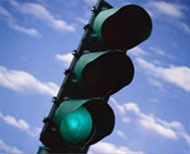11/15/2007
Short Green Times Trapping Drivers at Camera IntersectionsRed light cameras in some cities may depend on short green timing to create a steady flow of citations.

The relation of short yellow timing at intersections and ticketing revenue has been at the forefront of public discussion of photo enforcement since at least 2001 when a congressional report raised questions about the practice. This week, investigative reporters in two different states reported on shortened green time as a factor in red light camera ticketing. Lufkin, Texas motorist Nathaniel Shaw told KTRE-TV's investigative reporters about what he saw as a trap laid at the intersection of Chestnut and Timberland.
"I can guarantee you it does not stay on green when you cross over Timberland it does not stay on green more than three seconds," Shaw said. "More than five seconds at the most. Maybe three cars get through then all of a sudden you have to stop."
Although Texas Department of Transportation standards suggest the signal should stay green for a minimum of eight to ten seconds, KTRE timed the light at between three and five seconds of green. Shaw and others find this to be an inadequate time to clear the intersection, and each time someone fails to slam on the brakes in time, Lufkin will pocket $22.50, the state of Texas takes $22.50 and German red light camera vendor Traffipax earns $30. Officials say the timing results from programming designed to optimize traffic flow during peak traffic periods.
In Saint Louis, Missouri, similarly short green timing was blamed on a "malfunction." At Forest Park Parkway and Grand, KSDK-TV investigative reporters clocked the green at just six seconds. Saint Louis Deputy Traffic Commissioner Ken Cox confirmed that the green should be longer, but rejected the idea that anyone trapped by a malfunctioning light might deserve a refund.
"It's not about making money, it's about safety," Cox told KSDK.
As of September, Saint Louis has issued $1.4 million worth of red light camera tickets.
In 2001, a court obtained confidential documents from the red light camera vendor now doing business as Affiliated Computer Services (ACS) that show how the system operated in San Diego, California. The vendor explains the exact criteria used for the selection of intersections where red light cameras were to be installed, offering an insight into whether green timing has ever been a consideration.
Although San Diego officials at the time insisted that "high accident" intersections were the priority, not one of the top accident intersections received a camera. Instead, the primary criteria actually used were: short yellow times ("amber phase less than 4 seconds") and "high traffic volume." San Diego rejected placement of red light cameras in at least twelve intersections specifically because the "timing of lights clears out traffic." This factor may describe a shortened green scenario.
Despite media reports at the time, the 2001 congressional report did not suggest cities shortened yellow times after the installation of red light cameras. Rather, it described technical changes to engineering practices over a fifteen year period that resulted in shortened timing nationwide among cities that adopted the new practices. A sample intersection out of a 1976 textbook might have a 5 second yellow time; the same location would have a 4 second yellow under the 1999 formula -- a twenty percent reduction (view report).


